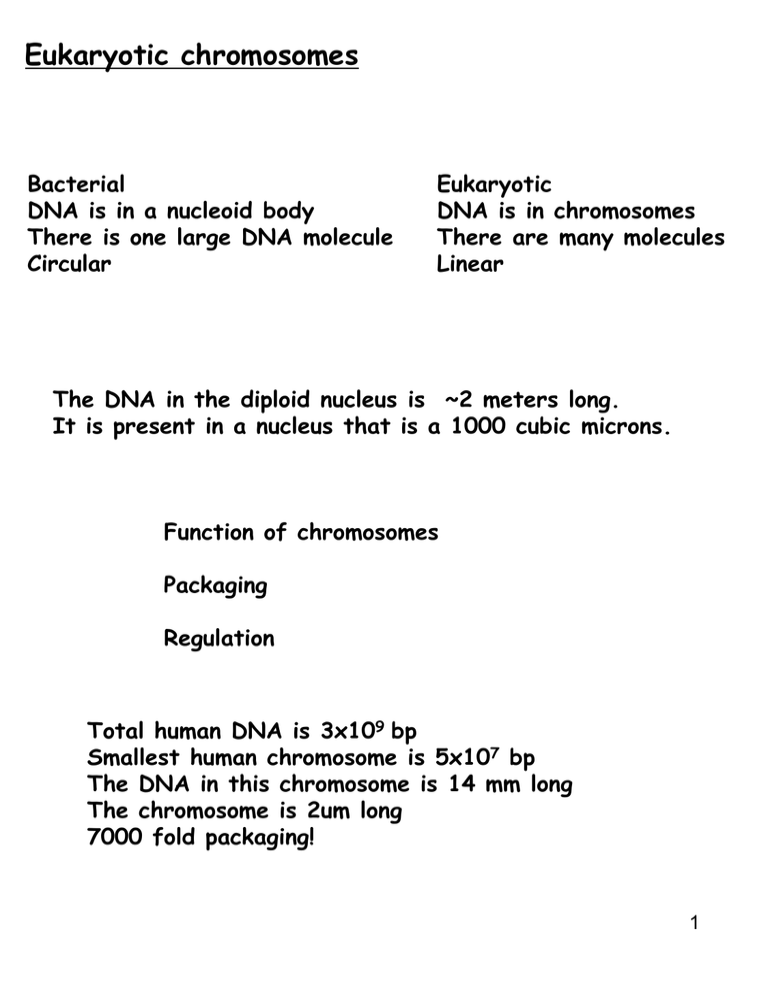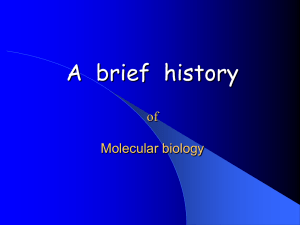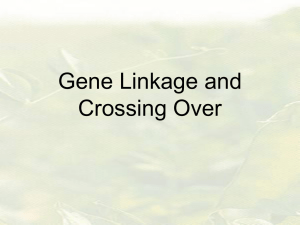
Eukaryotic chromosomes
Bacterial
DNA is in a nucleoid body
There is one large DNA molecule
Circular
Eukaryotic
DNA is in chromosomes
There are many molecules
Linear
The DNA in the diploid nucleus is ~2 meters long.
It is present in a nucleus that is a 1000 cubic microns.
Function of chromosomes
Packaging
Regulation
Total human DNA is 3x109 bp
Smallest human chromosome is 5x107 bp
The DNA in this chromosome is 14 mm long
The chromosome is 2um long
7000 fold packaging!
1
Amount of DNA varies between species
Amount of DNA varies in eukaryotes
Salamander genomes are 20 times larger than human genomes
Barley genome is 10 times larger than the rice genome
Barley and rice are related.
Measurements of DNA length
Amount of DNA/nucleus = C value
Species
DNA content (pg or 10-12g)
haploid
Sponge
Drosophila
Human
Lungfish
Locust
Frog
Yeast
0.05
0.2
3.5
102
46
4.2
0.03
2
C-Value paradox
This is often called the C value paradox.
There is no phylogenetic relationship to DNA content
There are sibling amphibian species - they look morphologically
identical but have 4-fold difference in DNA content
How do we account for the differences in DNA content/nucleus
No of genes
Gene size
Distance between genes
3
Junk DNA
1)
Number of genes could vary in these organisms
Lungfish would have to have 30 fold more genes than humans
Barley and rice have the same number of genes but vastly
different DNA contents.
Number of genes does not correlate with amount of DNA in a
cell.
2)
Size of genes could increase as genomes increase
Drosophila genome is 30 times larger than E.coli
Average coding region of a gene is 1-2 kb long in Drosophila
E. Coli genes are only slightly shorter
Drosophila genes are not 30 times larger than E. coli genes.
Introns and promoters etc increase the size to some extent but
cannot account for all of the increase.
3)
Amount of DNA between genes increases
Humans= 25,000 genes. Size of human genome is 3x109 bp
Yeast= 6000 genes. Size of yeast genome is 1.4x107 bp
The DNA between genes (intergenic region) varies.
A large fraction of intergenic DNA is repetitive
Nearly 60% of the human genome is repetitive.
Less than 5% of the yeast genome is repetitive.
4
Genome
Human Gene catalog
Vertebrates
46%
Eukaryote &
Prokaryote
21%
Human specific
<1%
Eukaryotes
32%
Human Genes are categorized according to their function, as
deduced from the protein domains specified by each gene.
5
Human Genes
Categorization of human genes
Genes whose function is not known are omitted
6
Repetitive DNA
7
Epigenetics and development
n + n
Differentiation
2n DNA content
same DNA content,
> 200 cell types
Gene packaging and why is it important
Epigenetics: Gene regulation through stable repression
Wolffe and Matzke, Science, 1999
Chromatin
A human cell contains about 2 m of DNA (1 m per haploid)
The human body consists of approximately 1013 cells and
therefore contains a total of about 2 × 1013 m of DNA.
Distance from the earth to the sun is 1.5 × 1011 m
The diameter of the nucleus is 5x10-6 meters
How is the DNA packaged?
Chromatin=
DNA
+histones
+non-histones
1g
1g
1g
10
2 nm (length 2m)
10 nm
30 nm
300 nm
700 nm
1400 nm
(length 2um)
DNA to chromosomes
Nucleosomes
Four histone proteins
H2A
H2B
H3
H4
Very highly conserved
There are two copies of
each core histone
2 mol H2A
2 mol H2B
2 mol H3
2 mol H4
1 mol H1
~200 bp DNA
DNA is wrapped around
the outside of the histone
octamer
166 bp of DNA wraps
around the histones
Linker DNA connects
nucleosomes
1 mol of linker Histone H1
A eukaryotic chromosome made out of self-assembling 70A unit, which could perhaps be
made to crystallize, would necessitate rewriting our basic textbooks on cytology and
genetics! I have never read such a naïve paper purporting to be of such fundamental
significance. Definitely it should not be published anywhere!
(Anonymous review of Woodcock Ms 1973, published in 1975)
12
Chromatin Loop Domains
13
xxxxx
14
Epigenetics and development
n + n
Differentiation
2n DNA content
same DNA content,
> 200 cell types
sperm
egg
Embryo
All Genes are poised for activity
Cell commitment
Specific genes activated
All other genes inactivated
Active genes maintain activity
Inactive genes remain silent
Active genes maintain activity
Inactive genes remain silent
16
Epigenetics and epigenetic regulation
Heritable changes in gene expression that do not involve
changes in DNA sequences
Genes contain coding regions and promoters
. examples:
•Developmentally regulated / tissue specific gene expression
•X chromosome dosage compensation
•Gene Imprinting
•Position effect variegation (PEV)
. mechanisms:
• Changes in Transcription factors
• Changes in DNA methylation
• Changes in Chromatin
Active Inactive
Transcription activator
+++
---
Repressor proteins
---
+++
DNA methylation
---
+++
Histones
+
+++
Histone Acetylation
+++
---
Gene activation
•examples:
•Developmentally regulated / tissue
specific gene expression
•X chromosome dosage compensation
•Gene Imprinting
•Position effect variegation (PEV)
Cell/tissue specific transcriptional activators bind to enhancers
of genes that have binding sites for these factors
-Aid in recruitment of enzymes that modify chromatin at the
promoter
- Aid in recruitment of the general transcription machinery
and RNA polymerase
Promoter TATA Inr
Gene
Enhancer
The enhancer functions to activate genes. There are specific
sequences that bind TISSUE SPECIFIC transcription factors.
The binding of these factors induces gene activation 100 fold!
18
Cell specific expression
Different Enhancers bind different
tissue and cell specific transcription
activator proteins and this enables
specific gene activation in specific cells
HNF3
Liver Cell
Liver
gene1
Brain
gene1
HNF3
Liver
gene2
Brain
gene2
Brain Cell
NZF2
Liver
gene1
Brain
gene
1
NZF2
Liver
gene2
Brain
gene
2
19
sperm
egg
Embryo
All Genes are poised for activity
Cell commitment
Specific genes activated
All other genes inactivated
Active genes maintain activity
Inactive genes remain silent
Active genes maintain activity
Inactive genes remain silent
mechanisms:
• Changes in Transcription factors
• Changes in DNA methylation
• Changes in Chromatin
DNA methylation
---
+++
Repressor proteins
---
+++
Histones
+
+++
20
Epigenetics and development
1.
2.
Differentiation
De-differentiation
2n DNA content
same DNA content
> 200 cell types
Cloning by nuclear transfer --> regenerate entire organism from
transfer of single nucleus (e.g. Dolly)
Induced pluripotent stem cells (iPS) --> expression of 4 genes are
sufficient to transform differentiated cells to “stem” cells
Both processes must involve reprogramming of epigenome!
Inactive chromatin
Heterochromatin
Inactive
Euchromatin
Active
Constitutive heterochromatin: Repetitive DNA-Centromeres,
telomeres etc
• Repetitive DNA tends to recombine expanding/contracting
repeats. Preventing repetitive DNA from recombination is
critical for cell survival
•Constitutes ~ 20 % of nuclear DNA
• Highly compacted,
• Always transcriptionally/Recombinationally inert
Euchromatin + facultative heterochromatin:
• constitutes ~ 80% of nuclear DNA
• less condensed, rich in genes,
•Euchromatin is transcriptionally active
• the rest is transcriptionally inactive (but can be activated
in certain tissues or developmental stages)
These inactive regions are known as “facultative
heterochromatin”
22
Gene Silencing and its importance
In any given cell, only a small percentage of all genes are
expressed
Vast majority of the genome has to be shut down or silenced
Knowing which genes to keep on and which ones to silence is
critical for a cell to survive and proliferate normally during
development and differentiation
Transcription factors bind active genes and keep them active
DNA methylation of inactive genes keeps them inactive
Cell commitment
Specific genes activated
All other genes inactivated
Active genes maintain activity
Inactive genes remain silent
23
DNA Methylation is not perfectly inherited
during development/aging
Twins
Fraga et al., 2005
PNAS
102(30):106049.
Facultative heterochromatin
Regions of genome, rich in genes that are condensed in specific
cell types or during specific stages of development
It includes genes that are highly active at a particular stage of
development but then are stably repressed.
X-chromosome inactivation in vertebrates
Dosage compensation
No. of transcripts are proportional to no. of gene copies
Diploid- 2 copies of a gene
Genes on X-chromosomes
In females there are two copies of a gene. In males there is
one copy.
XX
2
XY
1
Measuring transcript levels for genes on the X chromosome in
female and male show that they are equivalent.
Dosage imbalance is corrected!
25
Dosage compensation
•examples:
•Developmentally regulated / tissue
specific gene expression
•X chromosome dosage compensation
•Gene Imprinting
•Position effect variegation (PEV)
In Drosophila in the males there is an increase in transcription
from the single X chromosome. A inhibitor of transcription is
turned off in males allowing for full expression from the one X
chromosome
In nematodes there is a decrease in transcription from both
X chromosomes- protein binds the 2X chromo and causes
chromosome condensation which reduces transcription.
In mammals, X chromosome inactivation occurs in females by
26
formation of heterochromatin on one X chromosome
Mammalian X-chromosome inactivation
Mammalian males and females have one and two X chromosomes
respectively.
One would expect that X-linked genes should produce twice as
much gene product in females compared to males. Yet when one
measures gene product from X-linked genes in males and females
they are equivalent.
This phenomenon, known as dosage compensation,
X chromosome inactivation in females is the mechanism behind
dosage compensation.
In females, one of the X chromosomes in each cell is inactivated.
This is observed cytologically. One of the X-chromosomes in
females appears highly condensed. This inactivated chromosome is
packaged into heterochromatin and forms a structure called a
Barr-body.
27
Dosage compensation
Dosage compensation in mammalian females occurs by shutting
off of most of the genes on one X chromosome in females.
The inactive X chromosome becomes heterochromatic.
It is called a Barr body
XCI is random.
It occurs at the 500 cell stage of the embryo
For a given cell in a developing organism, probability of the
maternally or paternally derived X being inactivated is equal.
Once inactivated, it is stably propagated so that all the
thousands or millions of cells descended from that embryonic
cell maintain the same chromosome in the Heterochromatic
state.
Xist is ON - Xist RNA coats the X- X chr is OFF
Tsix is on- Tsix pairs and inactivates Xist -X chr is ON
X chr with Xist gets methylated!!!!!
28
XY
XX
reactivate
X
egg
X
sperm
XX
XX
Tsix Active
XX
Xist Active
Xist RNA
Inactivates
Xist RNA
Coat inactive X- methylate DNA
29
Epigenetic mechanism #1: DNA methylation
• DNA methylation has long been correlated with repression of
gene expression
• DNA methylation mostly occurs on CpG dinucleotides
DNMTs
methyl group added
to the cytosine
methylation status is maintained
during replication/mitosis
X-inactivation
The inactivation of one of the two X-chromosomes means that
males and females each have one active X chromosome per cell.
X-chromosome inactivation is random. For a given cell in the
developing organism there is an equal probability of the female or
the male derived X chromosome being inactivated.
31
X-inactivation
zygote
Embryo
Inactivation
The embryo is a mosaic!
Once the decision is made in early development, then it is
stably inherited.
Patches of cells have the male X ON and patches of cells have
the female X ON
32
This is a Developmental rule that overlays on top of Mendellian
rules!
Barr bodies
·
The inactive X-chromosome in normal females is called the
barr body
.
XXX individuals have 2 Barr Bodies leaving one active X
·
XXXX individuals have 3 Barr Bodies leaving one active X
·
XXY individual have one Barr Body leaving one active X
(Klinefelter's syndrome)
·
X0 individuals have no Barr Bodies leaving one active X
(Turner's syndrome)
Given X-chromosome inactivation functions normally why are they
phenotypically abnormal?
Part of the explanation for the abnormal phenotypes is that the
entire X is not inactivated during Barr-Body formation (Escape loci)
Consequently an X0 individual is not genetically equivalent to an XX
individual.
XX female
XXX female
XY male
XXY33male
Mosaic expression
XmXf
XmXf
XmXf
XmXf
XmXf
XmXf
XmXf
XmXf
XmXf
Xm
Xf
Xm
Xf
XmXf
XmXf
Xm
Xf
Xm
Xf
34
Tortoise shell cats
Black
Orange
Enzyme O
The O gene is carried on the X chromosome.
Female cats heterozygous for the O gene on the X- chromosome
have a particular pattern called Tortoise shell.
According to Mendel’s rules the cats should be either orange or
black.
But the cats are neither! They are Tortoise shell.
35
Tortoiseshell cats
All tortoiseshell cats are female
XY male
If normal O gene is present on the X, the male is ginger
otherwise he is black
Female with O/O are ginger
Females with o/o are black
Females with O/o are tortoiseshell
In O/o females
X-chromosome inactivation happens at random
Some cells activate O gene making ginger pigment
Some cells activate o gene making black pigment
36
Tortoise shell cats
According to Mendel’s rules these cats should be either orange or
black. But the cats are neither! They are Tortoise shell.
OO
x
oY
F1 females are Oo
37
Tortoise shell cats
Female cats heterozygous for the O gene on the X- chromosome
have a particular pattern called Tortoise shell. According to
Mendel’s rules these cats should be either orange or black. But
the cats are neither! They are Tortoise shell.
38
Imprinting
Occurs on Autosomes
•examples:
•Developmentally regulated / tissue
specific gene expression
•X chromosome dosage compensation
•Gene Imprinting
•Position effect variegation (PEV)
Occurs only on some genes on autosomes
39
Calliphyge-eautfultt
Oklahoma 1983
Farmer observed sheep with Calliphyge!!!
Beautiful Behinds!!
He thinks---Ooh la la--*!*!*! $$
40% more muscle
7% less fat
20% increased profit
40
eautfultt
Calliphyge
Big bottom male
X
normal female
203 big bottom:209 normal
Calliphyge is Sex independent
(both males and females are big bottom)
Big bottom is autosomal dominant?
41
Big bottom male x
normal female
203 big bottom:209 normal
C
N
N
N
C
50% N
:
N
N
N
N
50%
C
N
100% normal
42
Not Sex linked- The callipyge gene is on autosome
CC
x
NN
100% Callipyge
NN
x
CC
0% Callipyge
Calliphyge gene is expressed when inherited from the males!!!
The calliphyge locus from mother is always silenced.
43
Callipyge
Normal female X Normal male
The callipyge locus
from mother is
always silenced.
Normal phenotype
female allele is imprinted
(turned off) and male
allele is expressed
Normal female X mutant male
*
Mutant phenotype
Normal allele (from
mom) is imprinted
(turned off) and
mutant allele (from
dad) is expressed
mutant female X Normal male
*
Normal phenotype
Mutant allele (from
mom) is imprinted
(turned off) and normal
44
allele (from dad) is
expressed
Imprinting
A small number of genes (~200) on autosomes
The allele from one parent is shut off.
In the egg/sperm, these genes are imprinted (turned off)
Imprinting leads to functional haploidy!
Gene is WT but no protein is made (i.e. mutant).
Abandoned safety net of diploidy.
Gamete
A=off
A=off
A=on
A=on
Somatic cell
45
The original imprint is erased in gametes and the new
imprint is established in progeny during gamete formation
Imprinted loci
46
Imprinting of the IGF-2 gene on chromosome 11p15.
Schneider D T et al. Cancer Res
2001;61:7268-7276
War of the sexes
Why are perfectly good genes turned off?
Many maternally imprinted genes (inactive on the maternal
chromosome) are fetal growth factor genes
Tug of war
Father contributes active genes to enhance growth- extract
as many maternal resources for offspring as possible. He is
unlikely to mate again with that female. Advantage for
survival of his gene pool.
Mother silences these growth promoting genes to ration her
investment to any one offspring conserving resources for
future.
48
Callipyge locus
DLK1
GTL2 PEG11MEG8
effector
M
P
repressor
Mc
M
Mc
P
Pc
Pc
49
Model
Susan K. Murphy et al. Genome Res. 2006; 16: 340-346
50
Don’t
CN
x
CN
If C is autosomal dominant
Callipyge : normal
3:1 CC
CN
NC
NN
Actual ratio is
Callipyge : normal
1:3 CC
CN
NC
NN
51
Xxxxxxxxx
52
Properties of active/inactive domains
Active
Inactive
Accessibility
+++
---
Histone Acetylation
Histone H1
Repressor proteins
DNA methylation
+++
-----
--+++
+++
+++
53
Nucleosomes and transcription
TFIID cannot access the TATA box (Promoter) when
packaged in nucleosomes
Some transcription factors cannot access their binding
sites (Enhancers) in nucleosomes
54
55
Repeats
56
Heterochromatin
Euchromatin
Heterochromatin
Most heterochromatin is made up of repetitive DNA sequences
and retrotransposon repeats.
Small 5-12 bp DNA sequences repeated 100,000s times
Common sequences of the repeats
Drosophila
(AACAA)n
(AATAG)n
(AATAAAC)n
Yeast
(TGGG)n
Human
(CAGGG)n
(GGGCAAAAA)n
(GGAA)n
57
Heterochromatin
Heterochromatin is concentrated around
Centromeres- centromeric heterochromatin
Telomeres- telomeric heterochromatin
Heterochromatin on chromosome arms- intecalary
Some chromosomes are almost entirely heterochromatic
Drosophila Y chromosomes
Specific proteins bind DNA in heterochromatin.
Genes in heterochromatin are inactive.
Recombination is reduced
In yeast <10% of genome is heterochromatic
In Drosophila 30% of genome is heterochromatic
In humans > 50% of genome is heterochromatic
What is the function of heterochromatin
Heterochromatin is found in all eukaryotes
**In some organisms loss of heterochromatin is not lethal
Therefore its role must not be very important?!
**Loss of heterochromatin affects longevity (shortens life span)
**Loss of heterochromatin increases non-dysjunction
58
Heterochromatin
Since heterochromatin reduces recombination
Is increases in genome size due to loss of recombination
control?
What is the function of junk DNA/heterochromatin?
Majority of the DNA is useless????
***Anti-parasitic?
Retrotransposons insert into the genome, hop around and are
mutagenic. Heterochromatin would prevent their insertion,
hopping around and thereby reduce mutations.
Buffer against mutagenesis?
Plasticity during evolution?
59
Facultative heterochromatin
Regions of genome, rich in genes that are condensed in specific
cell types or during specific stages of development It includes
genes that are highly active at a particular stage of
development but then are stably repressed.
X-chromosome inactivation in mammals.
Dosage compensation
No. of transcripts are proportional to no. of gene copies
Diploid- 2 copies of a gene
XX
2
XY
1
Measuring transcript levels for genes on the X chromosome in
female and male show that they are equivalent.
Dosage imbalance is corrected!
In nematodes there is a decrease in transcription from both
X chromosomes- dpy27 binds the 2X chromosomes and causes
chromosome condensation which reduces transcription.
In Drosophila in the males there is an increase in transcription
from the single X chromosome. A inhibitor of transcription is
turned off in males allowing for full expression from the one X
chromosome
60
In mammals, X chromosome inactivation occurs in females by
formation of heterochromatin.
Mendocino 2004 Prop H-Ban use of genetically modified organisms
DNA or Deoxyribonucleic acid means a complex protein that is
present in every cell of an organism and is the blueprint for
61
the organisms development










